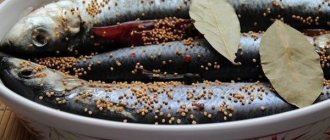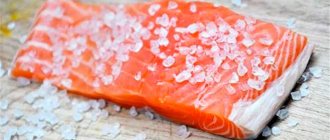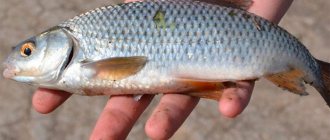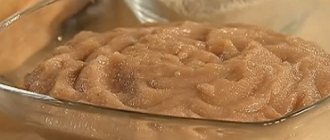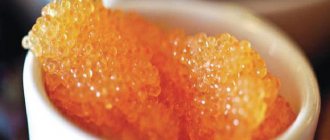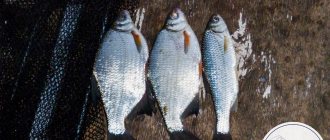What kind of fish can be salted and dried?
Absolutely any fish can be salted and dried, but it is generally accepted that the most delicious are fatty and medium-fat river fish. These types include:
- Bream, white bream;
- Roach, roach, ram;
- Bluefish, peled;
- Chekhon;
- Catfish;
- Flounder;
- Smelt;
- Capelin;
- Ide, chub, asp and some others.
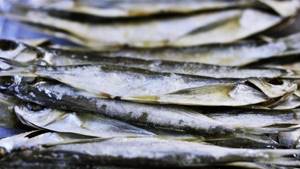
Low-fat fish can also be salted, but when dried it turns out dry. Such a fish is, for example, pike. Although, there will always be pike lovers.

Despite the sufficient fat content of fish such as carp, tench, crucian carp, they are not always suitable for salting and drying, since depending on the habitat, their meat may have a specific lake smell. However, river carp and crucian carp are almost free of this drawback, and salting fish with spices can make any fish tasty.
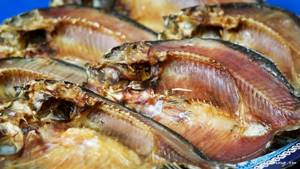
According to the time of catch, the fattest fish are those caught in the fall and early winter. In winter, the fish feeds poorly and loses excess fat, but during the diet its meat is cleaned, and therefore spring fish is also valued in its own way. The meat of fish caught in late winter and early spring is the cleanest, and after drying small fish it becomes translucent.
What about red fish? You can salt red fish in the same way as typical river fish. Any type of anadromous or local salmon is excellent for salting and drying.
How to properly salt red fish at home
First - preparation, so that you can immediately appreciate the simplicity and clarity of the recipe. And after the instructions with photos, we will tell you how to choose a good red fish and explain the secrets of success.
We need:
- Pink salmon (salmon, chum salmon) - 500-600 grams
- Salt (coarse) - 1 tbsp. spoon
- Sugar - 1 tbsp. spoon
- Patience to wait for the salting process - from 1 to 3 days
How we cook.
We wash a fresh pink salmon carcass without scales in cold water under the tap. Dry with napkins and arm yourself with a convenient knife.
When cleaning, our goal is to get boneless, skin-on fillets. We cut along the back from the head (!) along the ridge - so that one part of the fish remains with the spine. We cut off the head with gills and proceed to selecting the bones. Often the fillet is quite soft; we remove it from the bones by picking up each rib with our fingers. If that fails, tweezers come to the rescue.
Turn the part with the spine over with the skin side up and separate the fillet from the spine, starting to cut from the tail (!). Where to start moving is an important nuance; it is shown large in the photo below. We move smoothly so that the knife does not slip, does not cut the flesh across, or pierces the skin.
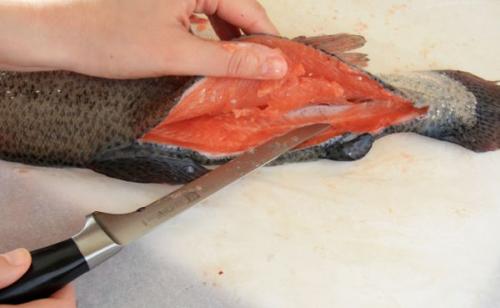
As a result of simple manipulations at home, we get excellent fillet with skin on it - no worse than store-bought packages.
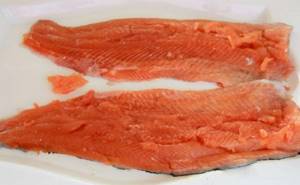
Salting is even easier than cleaning! Our choice is the dry method (without marinade), where you only need sugar and salt in equal proportions. In this recipe - 1 tbsp. spoon for 0.5-0.6 kg of fish. This way we will get juicy and beautiful fish pulp - without loss of color and nutrients.
Salting algorithm:
- Fillet in a glass bowl - Mix salt + sugar - Distribute the mixture evenly and generously over the fish pieces (sprinkle and stroke with your fingers on both sides of the fillet) - Cover with a lid and put in the refrigerator.
Important! After standing for a while, the fish will give juice, drain it from the container so that the fillet retains its elasticity.
We pickle it for 1 to 3 days - out of love for salty things.
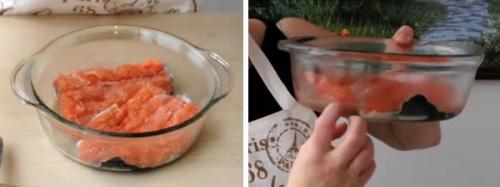
If you have mistrust, and suddenly it won’t be salted quickly, calm your doubts by putting a little pressure on the product (a saucer the size of it and something heavy on top).
As you can see, the process was completed in a few lines. Now you just have to be patient and wait for the fillet to be salted. Of course, you can add ground spices and chopped garlic to the pickling mixture, or top the fish with lemon slices. But even in ours - the simplest! - a recipe with a photo guarantees an excellent result.
How long to salt red fish? We love lightly salted: salting it takes 1-1.5 days. If you like medium salting - 2 days, strong - 3 days (in the store we most often come across strong). There is no point in salting fish for more than 3 days; it will become ultra salty, bordering on bitterness. Those who know how to salt red fish at home are very lucky, because we can vary the degree of salting ourselves. Join us for profitable culinary freedom!
Methods for salting fish
There are two main ways of salting fish for drying - “wet” and “dry” salting. Both methods make it possible to get equally tasty dried fish.
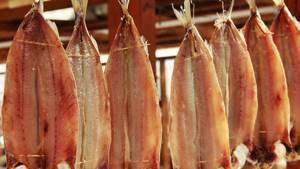
Dry salting is more often used for preparing large fish, and salting in brine is used for small and medium-sized fish. Another feature of salting fish in brine is that the meat of the finished fish is more tender.
For dry salting, you will need a container with holes or slits through which the juice released from the fish will drain (a wooden box, a plastic container with holes).
For salting fish in brine, any container with a salt-resistant coating (plastic, enamel dishes) is suitable. Aluminum containers for salting fish are not suitable, as their surface will oxidize and release impurities harmful to health.
Any salting method consists of the following steps:
- Preparing fish for salting;
- Salting fish;
- Preparing fish for drying, soaking.
Let's look at each stage in more detail.
How to salt river fish - simple rules and tips
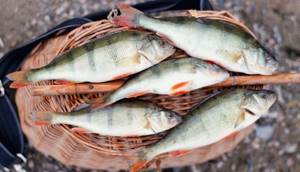
In this article we will share with you simple secrets on how to salt river fish. Small or large, dry salted or in brine, for drying or drying.
The beauty of fishing for many lies not so much in the process itself, but in the direct preparation of the caught fish.
Salting is the most popular processing option for river catch. Read on to learn how to salt fish at home.
Preparing fish for salting
Fish selected for salting must be clean and exceptionally fresh. The fish is not of the first freshness, and as a result, it turns out to be smelly, or completely unsuitable for consumption.
Large and sometimes medium-sized fish are freed from their entrails. Very large fish are completely or half-spread. An incision is made from the back along the ridge and, less frequently, from the belly.
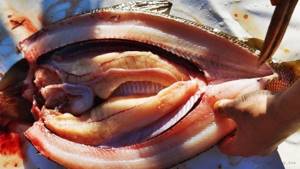
Layering the fish allows you to speed up the process of salting and subsequent drying. In addition, the risk of spoilage of layered fish during salting is reduced to almost zero.
Before salting, the fish is washed and excess water should be allowed to drain. Large fish are wiped with a dry towel.
Salting fish
To dry-salt fish, you will need 1.5-2 kg of salt per 10 kg of fish, for salting in brine - 1-1.5 kg of salt per 10 kg of fish. The salt should be coarse; fine table salt is not at all suitable for salting fish. You can use regular table salt or sea salt.
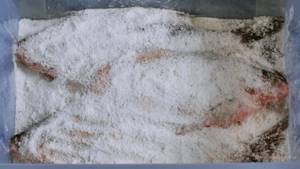
When salting fish, you should be guided by the principle “it is better to over-salt than under-salt,” since excess salt will be removed during the soaking stage, and its deficiency can lead to accelerated growth of bacteria and spoilage of the fish.
The process of salting fish must take place in cool conditions, so the fish is put into a cellar or refrigerator for salting.
Salting time depends on the size of the fish. Small fish are salted in two days, medium - 2-4 days, large - up to a week. Fish kept in a strong salt solution in cool conditions can be stored in it for a month or more.
Spices
In 99% of cases, fish is salted without using any spices, but if you want to give the fish an unusual or spicy taste, they can be added during the salting process.
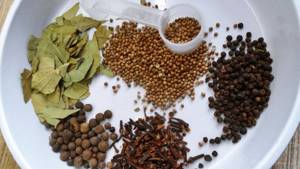
Regardless of the salting method, the following spices can be added to the fish:
- Allspice peas;
- Bay leaf;
- Nutmeg;
- Broken black pepper;
- Coriander;
- Carnation;
- Ginger;
- Cinnamon.
To these spices, you can add red capsicum, mustard seed, dill, cumin and anise - they all go well with fish, but any spices are good in moderation. To obtain a spicy salting, in addition to salt, you will need up to 50% sugar.
It should be borne in mind that spicy salting is best achieved when using medium-sized fish.
How to salt river fish - tasty and correct?
The most common method of heat treatment of catch is frying.
But what if there is simply no one to feed with a large number of fried trophies?
This is where salting comes to the rescue.
This process is quite simple and will allow you to extend the pleasure of eating fish for a considerable period of time.
Let's try to figure out how to quickly and tasty salt some types of river fish with our own hands.
Types of river fish optimal for salting
Fish is the healthiest product in nature, rich in various vitamins and microelements.
It is ideal for drying or salting.
River fish caviar is also very useful.
Let's look at what types of river inhabitants love salt, and as a result, they make an excellent snack.
For salting, it is good to use all representatives of red river fish and all various small species of river fish (perch, roach, crucian carp, etc.)
Remember that the shelf life of salted fish is still not very long.
As a rule, freshness is maintained for two weeks, depending on the type of fish and the salting recipe.
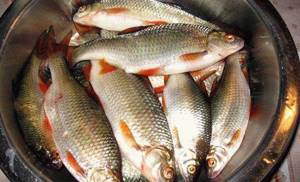
Methods for home salting river fish
There are various types of salting fish at home.
There are many types of homemade pickling, we will look at the two most popular:
- dry salting or cold salting;
- salting in brine;
The main rule before preparing salted fish is the right utensils and high-quality ingredients.
In order for the salting to be completed successfully, several rules should be taken into account:
- Utensils for mixing should be enamel or glass.
- It is necessary to choose rock salt and coarse enough, because... it will thoroughly saturate all layers of the fish.
- Freshly caught catch will be tastier, but if the fishing season has already passed, you can purchase a freshly frozen specimen and defrost it under hot water or at room temperature.
- Not every breed needs to be thoroughly cleaned and washed before salting.
Dry salted fish
Most often, river fish is salted using the dry salting method. We'll tell you about it.
- First, let's prepare a homemade marinade: put 150 grams of salt on a plate, and also add pepper, bay leaf and 50 grams of sugar.
- Thoroughly rinse the defrosted fish carcass under a cold water tap.
- Remove skin and bones (if possible);
- The carcasses should be placed on a plate with their back down and sprinkled with all the seasonings indicated in the list of products;
- We close our preparation and leave it in the refrigerator for three days.
In any salting recipe, you should always take into account that salt with small particles can only over-salt the fish fibers.
Another option for dry pickling.
- wooden container (this can be a basket or a small box);
- thick fabric;
- fish;
- sugar, salt
- We clean, rinse and dry the sockeye salmon.
- We place it on the bottom of the basket, having previously spread out a coarse cloth.
- We coat each of the fish with salt on all sides and not forgetting about the mouth and abdomen.
- Lay the carcasses evenly on the prepared surface. There should be no distance between the bodies.
- When everything is laid out, you need to close the box and press it down with a fairly heavy weight.
- Leave in a cool place for a week so that each fish is well salted.
- As soon as the scales become a little hard to the touch, they must be removed from the resulting juice and left to air dry.
How to salt perch for drying?
Preparing dried perch:
- We wash the perches under cold running water.
- Pour coarse salt into the bottom of an enamel pan.
- The salt layer should be no thinner than 0.5 cm.
- Place the fish tightly on top of the salt.
- Sprinkle with salt again.
- Once again we lay out the perches, etc. until we post everything.
- The final row should consist of salt.
- We close the container and press it with significant weight.
- Leave the pickling in a dark place for about a month or 40 days.
- After the above period, the carcasses must be distributed along the length.
More well-fed representatives need to be soaked for about 1.5 days, changing the water in a barrel (or any vessel suitable for pickling) three times.
Water calculations are based on 5 liters of cold water per 2 kg of fish. The salting process itself should take place in a dark place with average temperatures. It is not recommended to close the lid completely!
Drain all the water and let it dry a little.
We stretch a strong rope in a well-ventilated area with low humidity. You can prepare wire hooks in advance or use old plastic clothespins.
We hang the perches by pinching their upper lip.
To slightly protect the product from drying out, you can cover them with gauze. If drying occurs in the summer, it is worth protecting the fish in advance from sudden precipitation.
To do this, you need to cover all the perches and crucian carp with plastic material. But at the same time, after the sun appears, such “cover” must be immediately removed.
Next, the question logically arises: “How many days does it take to dry river mining?”
And here you should rely on your instincts and personal preferences. It happens that a couple of days are enough for good drying, and sometimes it may take 4 or even 5 days.
Salting river fish yourself is not difficult and very tasty.
Properly selected ingredients and proper proportions will give ordinary river fish a unique aroma and unforgettable taste.
The problem, however, can be caused by the meticulous removal of bones from the fleshy veins.
But if you have a little patience, the result will exceed all expectations.
We hope now that you know how to salt river fish, you will do it more often.
Salting in brine
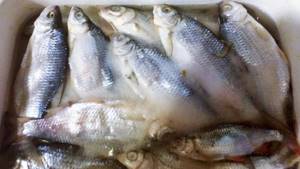
To salt fish in brine, you do not need to prepare a special brine; the juice released from the fish will be quite sufficient.
- The bottom of the container in which the fish will be salted is sprinkled with a layer of salt;
- The fish is placed sideways, in layers, each layer of fish is sprinkled with salt;
- The top layer of fish is completely covered with salt, covered with a lid on which a small weight is placed.
The weight is necessary so that when the brine is released, all the fish are immersed in it.
Immediately after salting, the fish is put into a cellar or refrigerator and salted there for 2-8 days, depending on the size of the fish.
How to salt herring in brine with oil.
This recipe is not much different from those described above; some people just like fish in brine with butter. The recipe is also simple and the fish is very tasty. We continue to learn how to salt herring at home, now with butter. According to this recipe, you can cut the fish into pieces. It tastes better to everyone here. Ingredients: Herring - 2 pcs; Salt - 2 tablespoons; Sugar - 1 tablespoon; Vegetable oil - 1 tablespoon.
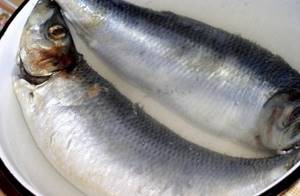
Salt the herring with butter Step 1. Wash the fish. We clean the inside, remove the gills and fins. You can also leave the caviar and milk. We rinse everything well again. Step 2. Put the water on the fire and boil it. As soon as it boils, add salt and sugar, stir until everything dissolves, and let the brine cool. Step 3. Now put the fish in a container, add oil to the water and pour the water into the fish. Cover with a lid and leave on the table for 3-4 hours. Then we put it in the refrigerator for 3 days. By the way, if the fish is cut into pieces, you can salt the fish in a jar.
Dry salting of fish

Salting fish using the dry method is not much different from salting it in brine, but the salt consumption and salting time are a little more.
- The bottom of a box or other container with holes is covered with canvas fabric (optional) and sprinkled with a layer of salt;
- Each fish is completely rubbed with salt and laid back down with a tilt to one side, or simply sideways, each new layer of fish is sprinkled with salt;
- The last layer of fish is generously sprinkled with salt, the fish is covered with a lid on which a small weight is placed.
After the fish is salted, the container with it is put away in a cool place - in the refrigerator or cellar, where it will remain for three to ten days, depending on the size of the fish.
Preserves
Salting fish is one of the ways to preserve a product, as well as a means of changing the taste characteristics of the finished fish product - dried, dried or smoked fish and snacks made from it. The main substance in table salt is sodium chloride. In addition to this compound, salt contains various impurities, the qualitative and quantitative composition of which depends on the place of extraction. There are two main types of salt:
- Table salt, also known as rock salt, is mined in salt mines.
- Sea salt (precipitated salt), mined from salty bodies of water
The difference between these varieties of salt lies in the chemical composition of the actual mass of the product ready for consumption. Self-planted salt contains more chemical elements and is recommended for daily use as a seasoning. Table salt in this regard is “purer”, that is, it contains fewer impurities, in particular iodine.
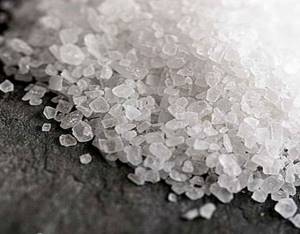
Soaking the fish
After the fish has been completely salted, it is necessary to get rid of excess salt - this is done by soaking. If this is not done, the fish meat will be dry and over-salted, its surface will be covered with salt crystals, and the released fat will quickly oxidize, and the fish will “rust.”
Soaking fish after salting is a very important step, on which the taste and quality of dried fish depends.
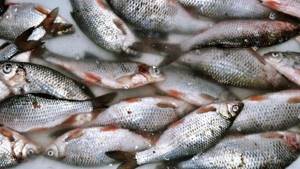
Before soaking, the fish is washed to remove any remaining salt. The soaking process is carried out in cold water, the volume of which should be significantly larger than the fish. Ideal conditions are soaking in running water, but if this is not possible, the water is replaced several times with fresh water.
The same amount of time in hours is allotted for soaking as the number of days it was salted, but it makes no sense to soak for longer than 5-6 hours.
After soaking, the fish is completely ready for drying.
Is it possible to dry fish without scales?
Usually, when drying fish, scales are not removed for the following reasons:
- it protects the internal tissues of the carcass from deformation and contamination
- when salting, this will protect the meat from being severely corroded by salt
- the absence of scales will lead to excessive drying of the product
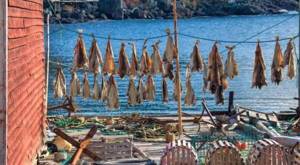
In some cases, the scales are removed from the fish. As a rule, this is done with large specimens or for the purpose of more convenient use of the finished product. However, experts say that such fish is less tasty, as it turns out to be too dry and unflavoured.
Drying fish
Many fishermen build a special drying cabinet on the balcony, which provides forced ventilation. But if there is no such device, the only way out is to hang the fish in any convenient place on ropes.

The place in which the fish is dried should be in the shade, preferably ventilated and cool.
The fish is suspended by the head or tail using hooks that can be made from paper clips or wire. If the fish is hung by the head, the fish meat will retain more fat; if by the tail, the risk of bile getting into the meat of ungutted fish is eliminated.
If the fish is suspended by the head, it is pierced with a hook in the jaw area or through the eyes. When suspended by the tail, it is pierced at the base of the caudal fin. Some anglers hang the fish by the tail using clothespins.
When hanging fish, you need to take into account that during drying, fat will drain and drip from it.
To protect against flies waiting for the moment when you hang the fish, it should be covered with gauze so that it does not touch the fish itself. It is best to hang fish for drying at night when there are no flies. During the night, the fish will become airy and will no longer attract insects as much.
You need to remove the fish without waiting for it to dry completely, especially if you are not going to eat it right away. During storage, the fish will quickly reach the desired degree of dryness.
How and for how long to dry fish in an electric dryer?
Many people use an electric dryer to speed up the process of drying and drying fish. Such a device is convenient in that elevated temperature and forced ventilation help accelerate dehydration of the product.
Features of this method:
- It is not necessary to marinate the fish for a long time, 7 hours is enough
- at 50 degrees the fish is dried for about 5-7 hours. At a higher temperature, the carcass can simply steam and the meat will separate from the bones. Some advise not to turn on the heating awning at all, but to set the device to the blower mode. This way the fish will dry longer – about a day.
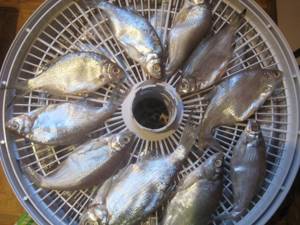
Drying fish in an electric dryer
- To speed up the process, you can dry the fish not whole, but by cutting it into layers
- Dried fish, pieces of which were marinated in a marinade of 0.5 cups of lemon juice, 5 tsp, is very tasty. salt, 2 tbsp. chopped parsley and 1 chopped onion
Storing dried fish
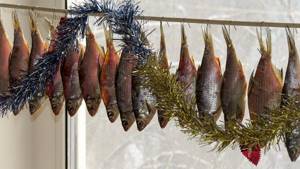
Any dried fish will dry out and become dried out over time, but this is not the only problem. When storing fish in conditions with access to light and air, salt is released on its surface, its fat oxidizes, the fish “rusts” and goes rancid. In conditions of high humidity, there is a risk of fish spoilage due to mold and the development of dangerous bacteria.
It is almost impossible to create ideal conditions for storing fish at home, but it is possible to preserve dried fish for a long time. For those who love dried fish, drying out is not a problem at all.
There are several types of storage of dried fish, each of which has its own pros and cons, and shelf life.
Package
Wooden boxes, corrugated cardboard boxes, wicker baskets, linen and multi-layer paper grocery bags, kraft paper laminated with polyethylene, etc. are used as packaging for storing dried fish.
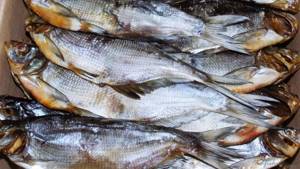
Studies of different types of packaging have shown that polyethylene bags and aluminum foil laminated with polyethylene are unsuitable, while kraft paper with one-sided polyethylene coating passed the test.
Storing dried roach in laminated kraft bags at a temperature of about 0 degrees showed that the product, after 6 months, retains an attractive appearance, normal meat consistency, pleasant smell and taste.
Normal storage
The fish is stored at room temperature, in a corrugated cardboard box or paper packaging of several pieces. Without much damage to the properties of the fish, it can be stored for a week. If stored in this way for a longer period of time, the fish gradually dries out.
Longer storage is possible using a refrigerator. Humidity and temperature in the refrigerator compartment are optimal. The fish is packaged in paper bags of several pieces and can be stored in this form for up to a month.
Over time, the fish dries out and the fat oxidizes, so other methods are used for long-term storage.
Popular recipes for salting fish
Salting fish at home is not a difficult task and can be done by a cook of any qualification. It will not be difficult for a novice housewife. Most recipes for salting fish at home are quite primitive and require the addition of only salt and water.
Among the most commonly used:
- sugar,
- peppercorns,
- carnation.
There are other components as well. This is vegetable oil, honey, ground pepper, curry, garlic, onion, herbs. Many recipes call for cutting the fish into pieces. But small fish can be salted whole.
According to your choice and taste, you can make it lightly salted or salty.
Classic pickling
For this method, you can select both small and large individuals. To salt 2 kg, use 6 tbsp. spoons of salt and 1 tbsp. spoon of sugar.
It is better to cut the dressed fish into equal parts. Each piece of fillet is coated in a mixture of salt and sugar. Place the slices in a glass jar and leave for 10 hours in a cool place.
Important! If you don't like the presence of sugar, you can do without it. But it is sugar that makes fish fillets softer.
Pickling in vodka
Take half a kilo of small or medium fish, as well as:
- 1 tbsp. a spoonful of salt;
- ½ teaspoon sugar;
- 10 g pepper;
- half a glass of vodka.
Fish fillets, sprinkled with spices and poured with vodka, should be kept under pressure for a day. After this, it is placed in a dark, cool place for 60 hours.
Pickling with honey
An old and very simple recipe. And the brine for salting fish is prepared only from salt, honey and water. And what’s especially important is that the product is ready super quickly. Just a couple of hours and you can enjoy a delicious snack. Most often, red fish is prepared this way, but any low-fat varieties are perfect.
You need to prepare 1 kg of fish and take:
- Half a liter of water;
- 4 tbsp. spoons of salt;
- 2 tbsp. spoons of honey;
- 3 tbsp. spoons of sunflower oil.
First, cut the fish into slices no thicker than 4 cm and place in a deep dish. It will remain in the brine for 45 minutes, after which the excess can be removed with a paper napkin. The fish is greased with oil and sent into the cold for an hour. If you need it lightly salted, you can eat it; if you want it saltier, let it sit for another hour.
Salting fish with ginger
Take a kilogram of fish and:
- water 1 l.;
- salt 200 gr.;
- sugar 1 tbsp. l.;
- bay leaf 4 pcs.;
- pepper 8 peas;
- cardamom and ginger.
The prepared carcass is sprinkled with salt and left in the cold. After a day, all the juice that she gave must be drained and filled with chilled brine. After 4 days, it is drained and replaced with a newly brewed one. After another 5 days they do the same. After two days, the fish is ready. If it turns out to be too salty, just keep it in cold water for a while.
Pickling in lemon juice
For 1 kg of fish you need:
- 4 tbsp. spoons of salt;
- 4 bay leaves;
- half a lemon;
- ground pepper.
The fish, cut into slices, is sprinkled with salt and pepper and sprinkled with lemon juice. Bay leaf is placed between the pieces (it can be chopped). The remaining lemon pulp is usually sliced and placed on top of the fish fillet. The product should stand in the refrigerator for two days. Before eating, wash off any remaining salt from the pieces of fish.
Salting in soy sauce
You will need half a kilo of fish, as well as:
- 3 tbsp. l. soy sauce;
- 1 tbsp. spoon of salt;
- ½ tbsp. spoons of sugar;
- 2 tbsp. spoons of lemon juice;
- 2 tbsp. spoons of vegetable oil;
The fillet is rubbed with a mixture of salt and sugar. Prepare a brine from the remaining juice, oil and sauce, pour it over the fish. After standing in the refrigerator for 3 days, you get a lightly salted delicacy.
In apple juice
Do you want to get herring (this fish is preferable to others for this salting method) with an unusual fruity flavor? This almost lightning-fast recipe for salting herring is a real find.
For 600 g of fish you need to take:
- 3 tbsp. spoons of salt;
- 2 tbsp. spoons of sugar;
- half a glass of apple juice;
- 10 g allspice (corns)
- 40 ml vegetable oil.
The finished fish fillet is cut into portioned slices. Apple juice, heated to 36℃, is mixed with vegetable oil, salt, sugar and seasonings. Herring, folded in a glass jar, is filled with brine. Once it has cooled completely, you can put it in the refrigerator for 2 hours. And everything is ready.


